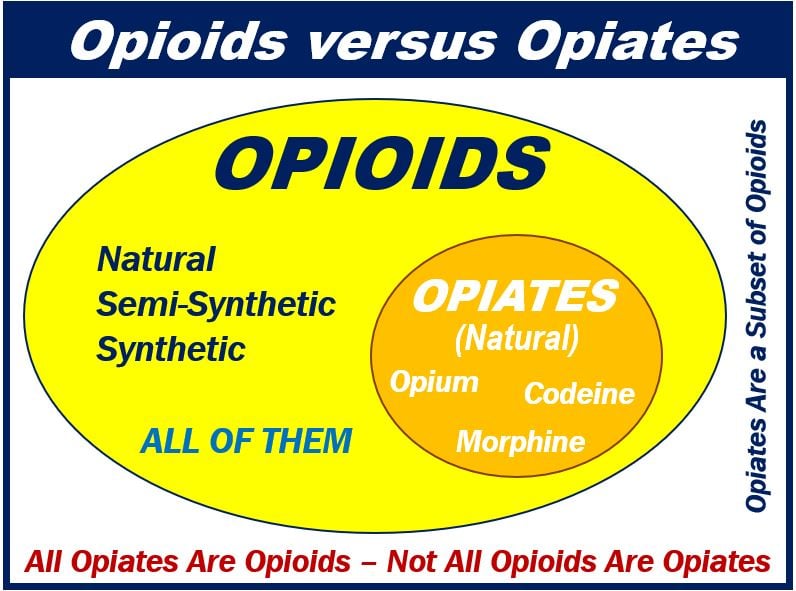Introduction
Sometimes the two terms Opiates and Opioids are used to mean the same thing. This is often a mistake, because although both have to do with opioids, they are not exactly the same. Opioids are a class of drugs, particularly those that include natural, semisynthetic, and synthetic ones. They’re substances that are used to reduce pain and act as anesthesia.
Opiates, on the other hand, refer to only natural opioids and not synthetic. Everything that has not been tampered with and has not been synthesized fits in this category.

Opiates vs. Opioids: Components
Since both deal with drugs, it is important to know that the specific materials and drugs are different.
Opiates: Natural
Opiates are natural drugs. They come from the opium plant, hence the name. They work on the opioid receptors in the body’s nervous system to dull the senses.
They include:
- Opium
- Morphine
- Codeine
Opium
Opium comes from the seedpods of the plant. It is known as Papaver somniferum and its seed capsules are cultivated after the petals have fallen. Medically, opium is used to relieve pain.
Morphine
Morphine is also natural and comes from the same poppy plant. It can be taken in several ways; inhaled, injected, or orally.
Codeine
Also natural, codeine is a natural phenanthrene; mostly colorless crystals. It is commonly used for pain as well as cough.
Opioids: Synthetic
Opioids include drugs that are manmade and have been tampered with. It is an umbrella term that also includes opiates. It adds to that the semi-synthetic and synthetic opioids. Thus, opioids include opiates and drugs done in laboratories.
They include:
- Natural
- Semi-synthetic
- Synthetic
Natural
As aforementioned, everything natural is classified under opiates. It’s what hasn’t been modified.
Semi-synthetic
This means that the opioid has been tampered with but it came from a natural source. Heroin, oxycodone, hydrocodone, and hydromorphone are all semi-synthetic opioids.
Synthetic
Synthetics are opioids created in labs and totally tampered with. Some examples are fentanyl and methadone.
Opiates vs. Opioids: Common Usage
Since they both fall under the category of painkillers in a way or another, they are sometimes used in surgeries and prescribed as pain-relief medicines.
Surgeries
Opioids are often used on patients as they undergo surgeries. They act as anesthesia to sedate the individuals and make sure that they don’t feel any pain. The U.S. has one of the highest average uses of opioids does in surgeries.
Prescription
Often as a follow-up for surgeries, pain relievers are prescribed by the doctor to ensure the patient’s pain-free recovery process.
The most common opiates prescribed are:
- Morphine (Kadian and Avinza)
- Codeine

The most common opioids prescribed are:
- OxyContin
- Vicodin
- Percocet
Illegal Usage
People often abuse their prescriptions and use both opiates and opioids illegally to get high. They might overuse the prescribed dosage, use someone else’s, or even get it illegally.
From Opiates to Opioids: Legality
At first, opiates were approved in medical instances and especially surgeries. It took a few years to realize that despite them being natural, opiates are heavily addictive and can lead to death. That’s why some were made illegal. To work around that, people have leaned towards synthesizing drugs; opioids.
OxyContin was then released as an attempt to make painkillers safe. However, some still found a way to misuse OxyContin.
Opiates vs. Opioids: Effects
Both opiates and opioids have similar actions in the body. They both attach to the receptors in the brain in order to relieve pain and soothe the body. They are mostly used for that purpose, which is medically approved.
Short-Term Effects
Short-term effects of opiates like opium and opioids like heroin.
Opium
Opium is an opiate; completely natural. It penetrates the brain much quicker than other opiates and gives the “high” effect in a few seconds. Some effects include:
- Relaxation
- Euphoria
- Slow heartbeats
- Loss of appetite
- Temporary constipation
If an overdose occurs, the person will have a very slow breathing pace, might lose consciousness, or have tiny pupils. Help is needed immediately.
Heroin
Heroin is a semi-synthetic opioid, made from morphine specifically. It can be used by injection, inhaling, or snorting. The effects include:
- Dry mouth
- Flushed skin
- Itching
- Nausea and vomiting
- Loss of concentration
Long-Term Effects
Long-term effects deal with what happens in the long run if the person continues to misuse opiates and opioids.
Long-Term Effects of Opiates
They include but are not limited to:
- Increase of tolerance and thus increase in doses
- Difficulty in having kids
- Dangerous dependence that needs regular doses
- Loss of appetite and sex drive
Long-Term Effects of Opioids
People who regularly use opioids may:
- Have heavy and exhausting insomnia
- Damaged veins because of the constant injections
- Infection in heart valves
- Liver and kidney diseases
- Loss of sex drive
Opiates vs. Opioids: Prescriptions
Prescriptions depend heavily on why the patient needs the drug. However, they are generally given with the smallest amount of doses. The doses increase or decrease with the following factors:
- Age
- Reason
- Severity of pain
With patients that have severe pain, doses should be increased by 50% and by 25 to 50% when the pain is mild.
Overdose: Opiates and Opioids
An overdose occurs when the person takes a much higher dose than prescribed. This leads to life-threatening incidents or death. The body and brain cannot handle that quantity and the organs start to shut down.
A person can overdose on both; opiates and opioids. The breathing slows down or even stops altogether because oxygen cannot reach the brain properly. This causes hypoxia; wherein the loss of oxygen becomes critical.
Hypoxia also has damaging effects. It directly affects the nervous system and can cause a coma to happen or permanent damage to the brain and cells.
Mixing Opiates and Opioids
Drugs should never be taken unless otherwise prescribed. However, when someone is addicted, mixing and taking whatever is incredibly harmful.
When done, this increases the risks of overdosing as well as accentuates the effects of opiates and opioids. Add to that, mixing them might send different signals to the brain, especially if the individual is drinking energy drinks at the same time. Opioids and opiates slow down the body, whereas energy drinks are supposed to accelerate and stimulate the mind.
Withdrawals from Opiates and Opioids
Withdrawal causes a lot of problems, especially if the person tries to quit ‘cold turkey’; stopping suddenly. The body is too used to the effects of both and cannot deal with the loss that quickly. Thus, withdrawal happens.
Around 24 hours after the last dose, the following effects start:
- Irritability and restlessness
- Loss of sleep
- Nausea
- Fast heartbeat
- Sweating
And withdrawal does not stop until help is provided. The person might be tempted to use again, just to stop the effects. That’s why professional help is immediately needed.
Opiates vs. Opioids: Cost
Opiates
Morphine is around $28 and available with a prescription. Codeine comes to around $35 and also available with the right prescription. Opium is the most expensive of the three and is around $128.
Opioids
OxyContin is expensive, coming to around $124. Oxymorphone is also expensive, around $286.
Opiates and Opioids Addiction
Addiction to both opiates and opioids can be easily developed when someone misuses the prescriptions or tries to get them illegally. It’s then that treatment centers are needed and professionals with experience in the field try to assist people who need help.
FAQs
Q) What are Opiates?
A) Opiates are natural drugs that come from the plant. They are not modified in labs, nor do they include synthesized materials. It’s why some argue that they should be completely legal.
Q) What are Opioids?
A) Opioids include natural opiates but also semi-synthesized and completely synthesized opioids. They are drugs that have been modified in labs or completely created.
Q) Are Opiates and Opioids the same?
A) Not quite. The word “opioids” is sometimes used to describe all, as an umbrella term. However, it is important to note that “opiate” deals with only what’s natural and what has been taken from the plant directly.
Q) If Opiates and Opioids can be prescribed, why are they illegal?
A) Some types are not illegal since they are prescribed. However, some drugs are incredibly strong and harmful to the body that they have been illegalized. Add to that, making them illegal prevents them from being easily accessed and therefore the misuse.
Q) Can an overdose on Opiates and Opioids lead to death?
A) Absolutely. It’s mainly why they’re so strongly advertised against. Individuals can develop a dependence, which leads to an addiction, which then leads to an overdose. Help is immediately needed in order to save the person.
Interesting related article: “What is Addiction?“

